| Documental Research | https://doi.org/10.21041/ra.v11i2.534 |
Revista Alconpat: 10 years of history (2011 - 2021)
Revista Alconpat: 10 anos de história (2011 - 2021)
Revista Alconpat: 10 años de historia (2011 - 2021)
P.
Castro-Borges1
*
![]() ,
E.
Sabido-Maldonado2,
J. M.
Mendoza-Rangel3
,
E.
Sabido-Maldonado2,
J. M.
Mendoza-Rangel3
![]() ,
P.
Helene4
,
P.
Helene4
![]() ,
P.
Garcés-Terradillos5
,
P.
Garcés-Terradillos5
![]() ,
A. A.
Torres-Acosta6
,
A. A.
Torres-Acosta6
![]() ,
M.
Fernández-Cánovas7
,
M.
Fernández-Cánovas7
![]() ,
R.
Husni8
,
R.
Husni8
![]() ,
O.
Troconis-Rincón9
,
O.
Troconis-Rincón9
![]() ,
F.
Branco10
,
F.
Branco10
![]() ,
J. I.
Escalante-García11
,
J. I.
Escalante-García11
![]() ,
F.
Alonso-Farrera12
,
F.
Alonso-Farrera12
![]() ,
M. A.
Olavarrieta-Parisot13
,
M. A.
Olavarrieta-Parisot13
![]() ,
,
1 Cinvestav del IPN, Unidad Mérida, Yucatán, México; Founding Editor in Chief, Alconpat Journal, México..
2 Alconpat-Internacional, Assistant Editor, Alconpat Journal, México.
3 Facultad de Ingeniería Civil, UANL; Founding Managing Editor, Alconpat Journal, México.
4 Universidad de Sao Paulo; Founding Associate Editor and Language Editor, Alconpat Journal, Brasil.
5 Universidad de Alicante; Associate Editor, Alconpat Journal, España.
6 Tecnológico de Monterrey, Campus Querétaro; Associate Editor, Alconpat Journal, México.
7 Universidad Politécnica de Madrid; Founding Associate Editor, Alconpat Journal, España.
8 Universidad de Buenos Aires; Founding Associate Editor, Alconpat Journal, Argentina.
9 Universidad de Zulia; Founding Associate Editor, Alconpat Journal, Venezuela.
10 Instituto Superior Técnico; Founding Associate Editor, Alconpat Journal, Portugal.
11 Cinvestav del IPN, Unidad Saltillo, Coahuila, México; Founding Associate Editor, Alconpat Journal, México.
12 Universidad Autónoma de Chiapas, México; Co-Editor in Chief (2020-2021), Alconpat Journal, México.
13 Universidad Centroccidental Lisandro Alvarado; Language Editor, Alconpat Journal, Venezuela.
* Contact author: pcastro@cinvestav.mx
| Cite as: Castro-Borges, P., Sabido-Maldonado, E., Mendoza-Rangel, J. M., et al. (2021), “Revista Alconpat: 10 years of history (2011-2021)”, Revista ALCONPAT, 11(2), pp. 146 – 157, DOI: https://doi.org/10.21041/ra.v11i2.534 |
Abstract
The objective of this paper is to present to the community the achievements attained and the challenges, met, current and coming, during the first ten years of existence of the Alconpat Journal. A narration is made of: how the idea of having a scientific/technical journal in Alconpat International arose; when, how and where the discussions and the project took place; the implementation, the first issue, the punctuality; the requirements and challenges to meet for the first indexations (Scielo México, Scielo WoS, Redalyc, Latindex, Google); the Conacyt projects that made it possible to gradually meet the requirements for eventual applications at higher indexes (Scopus and WoS), repositories, directories (DOAJ) and super servers; electronic markings, publication in three languages (Spanish, Portuguese and English), administrative times for timely publication, etc. The efforts of all those who have collaborated in these initial 10 years are also acknowledged.
Keywords:
Alconpat Journal,
Scielo,
WoS,
Redalyc, Latindex, Google Scholar.
Resumo
O objetivo deste trabalho é apresentar à comunidade as conquistas e desafios da Revista Alconpat em seus primeiros dez anos de existência. Narra-se: como surgiu a ideia de uma revista científica / técnica na Alconpat Internacional; quando, como e onde as discussões e o projeto ocorreram; como foi a implementação, a primeira questão, a pontualidade; os requisitos e desafios a cumprir para as primeiras indexações (Scielo México, Scielo WoS, Redalyc, Latindex, Google); os projetos do CONACyT que possibilitaram atender gradativamente os requisitos para eventuais aplicações em índices superiores (Scopus e WoS), repositórios, diretórios (DOAJ) e super servidores; marcações eletrônicas, publicação em três idiomas (espanhol, português e inglês), tempos administrativos para publicação específica, etc. Ao final, um extenso agradecimento a todos aqueles que participaram desses primeiros 10 anos.
Palavras-chave:
Revista Alconpat,
Scielo,
WoS,
Redalyc, Latindex, Google Scholar.
Resumen
El objetivo de este trabajo es presentar a la comunidad los logros y retos por venir de la Revista Alconpat en sus primeros diez años de existencia. Se realiza una narración de: cómo surgió la idea de tener una revista científico/técnica en Alconpat Internacional; cuando, como y donde se llevaron a cabo las discusiones y el proyecto; la implementación, el primer número, la puntualidad; los requisitos y retos a cumplir para las primeras indizaciones (Scielo México, Scielo WoS, Redalyc, Latindex, Google); los proyectos CONACyT que permitieron cumplir poco a poco los requisitos para eventuales aplicaciones a índices superiores (Scopus y WoS), repositorios, directorios (DOAJ) y super servidores; marcaciones electrónicas, publicación en tres idiomas (español, portugués e inglés), los tiempos administrativos para publicación puntual, etc. Al final se hace un extenso agradecimiento a todos los que han intervenido en estos 10 años iniciales.
Palabras clave:
Revista Alconpat,
Scielo,
WoS,
Redalyc, Latindex, Google Académico
1. Introduction
The idea of creating the ALCONPAT Journal came up within the framework of the 2003 CONPAT Congress, when the actual need to have a formal dissemination mechanism in said association was raised for the first time; a serious, academic, and original journal that would focus on its efforts on those subjects cultivated for almost 30 years in the Association. The evolution of the idea and the project took several years to consolidate, but everything was reinforced as the collection of quality works presented at CONPAT events increased. It was during the 2009 CONPAT Congress that the formal project for the creation of the Journal was formally presented to the Superior Council, the highest administrative body of the Association, obtaining its approval to officially start its activities in the following year. During 2010, intensive work was carried out on the design and implementation of the website to attend the mechanisms for sending, receiving, evaluating, and publishing articles; finally, on December 31, 2010, the first issue was electronically published, corresponding to the year 2011, making itself known as "ALCONPAT Journal" (or RA for its acronym).
In 2013, the legal information registry was generated, that includes the right of exclusive international use of the name “Revista ALCONPAT” and its corresponding ISSN number: 2007-6835 (Castro-Borges, et al. 2013).
In 2015, during the publication of the Volume 5, RA participated in the Call to belong to the index of Scientific and Technological Journals of Conacyt (National Council of Science and Technology - Mexico), achieving such distinction in the same year. This fact is a watershed that drove the RA towards higher standards, such as membership in prestigious indices, migration to the OJS (Open Journal System) platform and DOI (Digital Object Identifier) number, among others. Currently the journal has risen to the highest level of "Internationally Competent Journal" in Conacyt.
In 2016, thanks to the indexing of CONACyT, it was possible to incorporate the journal into the Scielo Mexico index, as well as into the SciELO Citation Index, a database that is part of the Web of Science. In 2017 RA started in Google Scholar where important data can be consulted.
In 2018 the RA applied for a long process towards its inclusion in Scopus, and a year later the feedback received suggested small changes, which were implemented and will be evaluated again in May 2021. In 2018 the RA was incorporated into other Indexes such as Redalyc, and in the OJS 2 platform a statistics section was incorporated to enable monitoring which articles are downloaded the most, which country visits us the most, which is the most consulted number, etc., as well as the implementation of publishing XML Jats. Similarly, the RA was included in 2018 in the Latindex Catalog and directory.
In 2020 the RA moved to the most recent and stable version of the OJS evaluation system (Version 3.2.1.4), a new portal design, with new built-in plugins such as XML Viewer, Catch module, article sharing module, etc.; the editorial and ethical policies were updated, accordance with the COPE (Committee on Publication Ethics) in order to increase visibility and accessibility. The option was chosen to change the Creative Commons license to a more open one with fewer restrictions (CC BY, https://creativecommons.org/licenses/by/4.0/), which is a requirement to belong to the DOAJ (Directory of Open Access Journals). Another important index requirement is the digital preservation system, that we currently have, an anti-plagiarism software license (iThenticate with Crossref Similarity Check), and also a Google Analytics tool, which provides individual statistics per item and other enhancements that will allow the entry, during 2021-2022, to DOAJ and probably to Scopus and JCR. It is noteworthy that the RA currently had an Impact Factor (IF) in Scielo Analytics (Table 1) of 0.03 in 2016, which later increased to 0.16 in 2019; we are confident that it will improve and be endorsed when it is incorporated into other indices.
| Table 1. Impact factor of the Alconpat Journal since 2016 (Scielo México) | ||||||||||||||
| Base year 2016 | Dating in 2016 | Articles published in | Impact factor | Appointments made in 2016 for articles of 2016 | Articles published in 2016 | Immediacy index | ||||||||
| Every year | 2015 | 2014 | 2015+ 2014 | 2015 | 2014 | 2015+ 2014 | ||||||||
| 7 | 0 | 1 | 1 | 18 | 18 | 36 | 0.028 | 0 | 22 | 0 | ||||
| Base year 2017 | Dating in 2017 | Articles published in | Impact factor | Appointments made in 2017 for articles of 2017 | Articles published in 2017 | Immediacy index | ||||||||
| Every year | 2016 | 2015 | 2016+ 2015 | 2016 | 2015 | 2016+ 2015 | ||||||||
| 7 | 0 | 1 | 1 | 22 | 18 | 40 | 0.025 | 2 | 22 | 0.091 | ||||
| Base year 2018 | Dating in 2018 | Articles published in | Impact factor | Appointments made in 2018 for articles of 2018 | Articles published in 2018 | Immediacy index | ||||||||
| Every year | 2017 | 2016 | 2017+ 2016 | 2017 | 2016 | 2017+ 2016 | ||||||||
| 13 | 2 | 1 | 3 | 22 | 22 | 44 | 0.068 | 0 | 16 | 0.0000 | ||||
| Base year 2019 | Dating in 2019 | Articles published in | Impact factor | Appointments made in 2019 for articles of 2019 | Articles published in 2019 | Immediacy index | ||||||||
| Every year | 2018 | 2017 | 2018+ 2017 | 2018 | 2017 | 2018+ 2017 | ||||||||
| 14 | 2 | 4 | 6 | 16 | 22 | 38 | 0.160 | 0 | 7 | 0 | ||||
As a result of the increased visibility of the RA, there has also been an increase in queries and downloads, as shown in Figure 1. The variety of countries that consult the RA is particularly striking, as can be seen in Figure 2, and in quantitative form in Table 2. The RA has been reviewed and/or downloaded in more than 130 countries; the trend in distribution of these downloads reflects, in some way, the geographical distribution of authors, access to information sources, the degree of scientific development, etc.
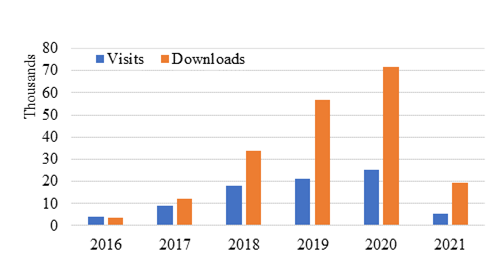 |
||||
| Figure 1. Downloads and visits to the page, number of queries to summarize the articles from 2016 to 2021. (source: OJS of the Revista Alconpat) | ||||
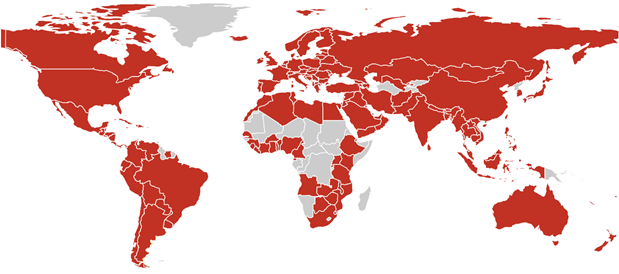 |
||||
| Figure 2. Countries with the highest number of visits, in red. (OJS from Revista Alconpat) | ||||
| Table 2. Countries with number of visits in 2020. | ||||||||||||||
| Country | No. of visits | Country | No. of visits | Country | No. of visits | Country | No. of visits | |||||||
|---|---|---|---|---|---|---|---|---|---|---|---|---|---|---|
| Brazil | 9303 | Indonesia | 89 | Nepal | 19 | Belize | 4 | |||||||
| Mexico | 3672 | Uruguay | 74 | United Republic of Tanzania | 17 | Senegal | 4 | |||||||
| United States of America | 3320 | Greece | 73 | Republic of Serbia | 17 | Togo | 4 | |||||||
| Peru | 2152 | Iraq | 70 | Denmark | 16 | Zimbabwe | 4 | |||||||
| India | 1685 | Australia | 65 | Lithuania | 15 | Yemen | 4 | |||||||
| Colombia | 1421 | South Africa | 64 | Mongolia | 15 | Belarus | 4 | |||||||
| Russia | 1138 | Honduras | 62 | Morocco | 14 | Jamaica | 3 | |||||||
| Spain | 886 | Dominican Republic | 60 | Bulgaria | 13 | Haiti | 3 | |||||||
| Bolivia | 783 | Poland | 60 | Austria | 13 | Iceland | 3 | |||||||
| Argentina | 565 | Malaysia | 60 | New Zealand | 13 | Benin | 3 | |||||||
| China | 565 | Egypt | 59 | Slovenia | 12 | Guinea | 2 | |||||||
| Germany | 456 | Thailand | 58 | Syria | 11 | Sierra Leone | 2 | |||||||
| Ecuador | 436 | Ethiopia | 56 | Albania | 11 | Liberia | 2 | |||||||
| Czech Republic | 408 | United Arab Emirates | 54 | Puerto Rico | 10 | Ivory Coast | 2 | |||||||
| France | 402 | Nigeria | 49 | Lebanon | 10 | Botswana | 2 | |||||||
| Portugal | 395 | Costa Rica | 48 | Kazakhstan | 10 | Djibouti | 2 | |||||||
| South Korea | 350 | Vietnam | 45 | Rwanda | 9 | Macedonia | 2 | |||||||
| Chile | 342 | Mozambique | 42 | Kuwait | 9 | Georgia | 2 | |||||||
| Ukraine | 325 | Israel | 40 | Qatar | 8 | Laos | 2 | |||||||
| United Kingdom | 298 | Belgium | 38 | Latvia | 8 | Surinam | 1 | |||||||
| Panama | 231 | Kenya | 37 | Estonia | 8 | Burkina Faso | 1 | |||||||
| Venezuela | 170 | The Savior | 36 | Afghanistan | 8 | Equatorial Guinea | 1 | |||||||
| Ireland | 170 | Angola | 32 | Cameroon | 7 | Swaziland | 1 | |||||||
| Canada | 168 | Norway | 28 | Uganda | 7 | Malawi | 1 | |||||||
| Italy | 160 | Ghana | 28 | Tunisia | 7 | Armenia | 1 | |||||||
| Philippines | 130 | Norway | 28 | Croatia | 7 | Azerbaijan | 1 | |||||||
| Sweden | 125 | Bangladesh | 28 | Zambia | 6 | Uzbekistan | 1 | |||||||
| Japan | 123 | Saudi Arabia | 27 | Cyprus | 6 | Bhutan | 1 | |||||||
| Netherlands | 118 | Switzerland | 27 | Cambodia | 6 | Myanmar | 1 | |||||||
| Cuba | 116 | Nicaragua | 26 | Trinidad and Tobago | 5 | New Caledonia | 1 | |||||||
| Turkey | 115 | Algeria | 26 | Libya | 5 | Fidji | 1 | |||||||
| Paraguay | 110 | Jordan | 26 | Bosnia and Herzegov | 5 | |||||||||
| Guatemala | 108 | Finland | 26 | |||||||||||
| Pakistan | 100 | Taiwan | 26 | |||||||||||
| Oman | 23 | |||||||||||||
The RA has the highest internationalization index considered by Redalyc, Figure 3, which is made up of 5 groups and 5 subgroups. The highest level of internationalization is defined by G1 and the lowest G5. This index is derived from three variables with different weights:
1. Proportion (%) of foreign authors (value 0.25);
2. Number of foreign countries (value 0.35);
3. Proportion of articles with at least one foreign author (value 0.45).
The level of internationalization of a journal allows observing the level of foreign participation.
Group G11 indicates the highest level of internationalization and G55 the least internationality or greater endogeneity. Redalyc considered the creation of the subgroups important because G21 indicates that it is very close to G1, while G25 indicates that it is much closer to G3 and with the probability of descending from the group. Maintaining the G1 is a challenge for any journal, and especially those that aspire belonging to important scientific indexes.
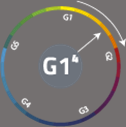 |
||||
| Figure 3. Internationalization index of the Revista Alconpat (Data and figure courtesy of Redalyc). | ||||
One of the challenges of the RA has been to maintain a standard in terms of timeliness and publication times. From the beginning, an optimal average trend was established towards 17 weeks (4 months) from submission to publication, which according to Redalyc has remained very close to 17.39 as shown in Figure 4.
 |
||||
| Figure 4. Average weeks of reception - acceptance of the Revista Alconpat: 17.39 weeks (Data courtesy of Redalyc). | ||||
Like other journals that are evaluated in various indexes, the Alconpat Journal must maintain a citable production, The trends in these 10 years have been those of an increase in citable production as denoted by research and review articles published since then. The distribution by type of article during these 10 years can be seen in Figure 5.
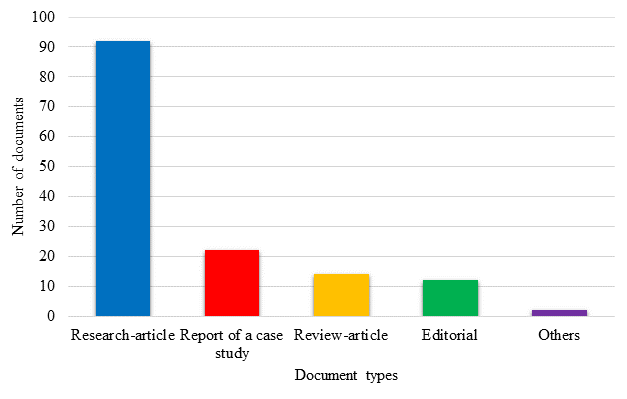 |
||||
| Figure 5. Distribution of documents by type of article (Data courtesy of Scielo Analytics) | ||||
Undoubtedly, the internationalization of the RA is still mostly from Latin America, as seen in Figure 6, although papers from the rest of the world are becoming more common. A strong influence from Brazil and Mexico have marked the course of the RA in these 10 years.
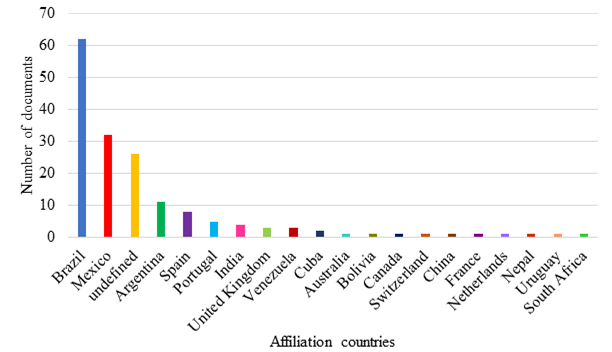 |
||||
| Figure 6. Distribution of documents by country of publication (data from Scielo Analytics) | ||||
The number of authors per article is an issue that increasingly involves evaluation in the Science and Technology Councils of our countries. Figure 7 shows this trend in the RA, showing a predominance of 3-4 authors, which is quite attractive for evaluation systems such as Mexico or Brazil. It is also worth noting the significant presence of articles with a single author, which denotes independence and leadership of the authors that choose the RA, which coincide with the trajectory of those authors regarding their citation.
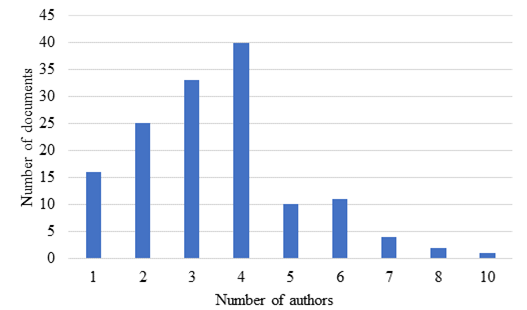 |
||||
| Figure 7. Distribution of documents by number of authors per article (data from Scielo Analytics). | ||||
Another important aspect in the quality of a Journal is the number of references in the papers, which for the RA the average is of around 20, see Figure 8, which is an acceptable number after taking into account that the citable production relative to basic or applied research articles and to reviews is around 2/3 of the total production, Figure 5.
To sum up, the RA has a general positive trend (upward, lasting, and constant step) in its modest statistics so far, which could be summarized in a gradual and constant increase of its impact factor, Table 1. By the time of this publication, we already have had feedback from DOAJ, so it is likely that, according to the plans, we will be applying with very good possibilities to Scopus and JCR.
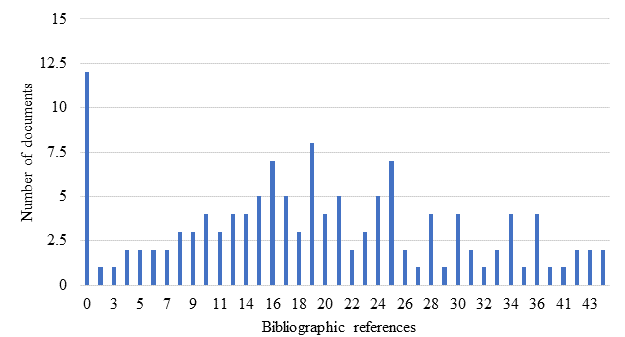 |
||||
| Figure 8. Distribution of documents by number of bibliographic references per article (Scielo Analytics) | ||||
The future of RA looks bright and fruitful. 10 years away, a wide recognition must be made of the original editorial staff and those who have joined this initiative, which has led us to where we are now. Undoubtedly, the greatest recognition belongs to our article authors, who have trusted our journal and invested time, money, and effort to publish their research work with us, despite the fact that many of them have had better options at their moment. Finally, our readers, whom without them we are nobody, deserve our appreciation for reading, downloading, and citing us; their preference will certainly provide the RA, in a short period of time, opportunities to continue improving through better tools for consultation and indexing. On behalf of the Editorial Board, many, many, many thanks to all of you. During 2021, and at the close of this edition, these 10 years were honored with an academic celebration on May 19; the schedule of said act is included here as a tribute for the posterity in the annex.
A special thanks are due to the National Council of Science and Technology (Conacyt) of Mexico, through which we have had the support of the projects (2013 call, declared as a competent national magazine (September 2, 2013), 2014 -2015 call, project no.140028 (October 30, 2014), call 2016, declared as an international competent journal (September 5, 2016), Call 2017, project 290978 (March 21, 2017) and the last call 2018-2019, project 297368 ( July 16, 2018) to finance Alconpat Journal in various stages that have allowed it to reach standards with which it has been possible to be applying and obtaining important indexes.
References
Castro-Borges, P., Mendoza-Rangel, J. M., Sabido-Maldonado, E., León-Chan, N., Balancán- Zapata, M. (2013), “La Revista ALCONPAT. Presente y futuro”, XII Congreso Latinoamericano de Patología de la construcción y XIV Congreso de control de calidad em la construcción CONPAT-Colombia, pp. I 16-23.
ANNEX
| Academic Celebration Program for the 10th Anniversary of Revista Alconpat May 19, 2021, Online, 09:00-13:00 (GMT-5) | ||||||||||||||
| 09:00-09:10 | Welcome remarks to the event by Carmen Andrade (President of Alconpat) | |||||||||||||
| 09:10-09:40 | Presentation on the history and statistics of the Journal, as well as the immediate and future plans (Pedro Castro Borges). | |||||||||||||
| 09:40-10:20 | Conversation between Associate Editors. Anecdotes, experiences, history, and open topics. Chairmen: Raúl Husni and Manolo Fernández Cánovas. Participants: Oladis Troconis de Rincón, Andrés A. Torres Acosta, Jorge Branco, Paulo Helene, Pedro Garcés Terradillos. | |||||||||||||
| 10:20-10:40 | Presentation and Recognition of the Editorial Board that has served in these 10 years, both in office and those who are no longer on the committee (Patricia Martínez, Sergio Espejo, Margita Kliewer, Mauricio López and Luis Fernandez, among others), chaired by José Manuel Mendoza Rangel. | |||||||||||||
| 10:40-11:00 | Presentation of New Associate Editors of the Journal (Ravindra Gettu from India and Filippo Uberttini from Italy) and Co-Editor in Chief, 2021-2022 (Edna Possan from Brazil). Chaired by Pedro Castro Borges. | |||||||||||||
| 11:00-12:45 | Short presentations of the most representative "Reviews and collection" (by subject, citations, downloads and time) of Alconpat Journal representing North and South America, Africa, Asia and Europe. Chaired by a member of the Editorial Committee for each work (see list below). Each Presentation is 12 minutes and 3 minutes for initial presentation and questions. | |||||||||||||
| 12:45-12:55 | Words by Paulo Helene, Associate Editor in Representation of the Editorial Board. | |||||||||||||
| 12:55-13:00 | Closing with e-toast of honor, Pedro Castro Borges. | |||||||||||||
Selected Reviews
2015
Integrated management systems building technique: inspection and repair of non-structural elements. PORTUGAL (42 REF). Chairman Pedro Garcés Terradillos.
G. T. Ferraz (IST, Lisboa; Portugal)
J. De Brito (Instituto Superior Técnico, Universidade Técnica de Lisboa).
V. P. De Freitas (Faculdade de Engenharia, Universidade do Porto)
J. D. Silvestre (IST, Lisboa; Portugal)
DOI:https://doi.org/10.21041/ra.v5i2.83
2017
Infrared thermography as a non-destructive test for the inspection of reinforced concrete bridges: A review of the state of the art. BRASIL (75 REF). Chairman Raúl Husni.
Joaquin Humberto Aquino Rocha(Universidade de Pernambuco, Brasil)
Yêda Vieira Póvoas Tavares(Universidade de Pernambuco)
DOI:https://doi.org/10.21041/ra.v7i3.223
2018
Service life design and modelling of concrete structures - background, developments, and implementation. SOUTHAFRICA (57 REF). Chairman Andrés Torres Acosta.
Mark Gavin Alexander (University of Cape Town)
DOI:https://doi.org/10.21041/ra.v8i3.325
2019
Adhesion, strengthening and durability issues in the retrofitting of Reinforced Concrete (RC) beams using Carbon Fiber Reinforced Polymer (CFRP) - A Review. MEXICO (67 REF). Chaired by Edna Possan.
Pedro J. Poot Cauich(Escuela de Ingeniería Civil, Universidad Marista de Mérida, Periférico Norte tablaje catastral 13941, Carretera Mérida - Progreso. C.P. 97300, Mérida, Yucatán)
Rodolfo Martínez-Molina(Escuela de Ingeniería Civil, Universidad Marista de Mérida, Periférico Norte tablaje catastral 13941, Carretera Mérida - Progreso. C.P. 97300, Mérida, Yucatán)
José Luis Gamboa Marrufo(Escuela de Ingeniería Civil, Universidad Marista de Mérida, Periférico Norte tablaje catastral 13941, Carretera Mérida - Progreso. C.P. 97300, Mérida, Yucatán)
Pedro Jesus Herrera Franco(Unidad de Materiales, Centro de Investigación Científica de Yucatán, A.C., Calle 43 # 130, Col. Chuburná, C.P. 97205, Mérida, Yucatán)
DOI:https://doi.org/10.21041/ra.v9i2.401
2020
Use of supplementary cementitious materials (SCMs) in reinforced concrete systems - Benefits and limitations. INDIA (39 REF). Chaired by J. Iván Escalante-Garcia
R. G. Pillai(Department of Civil Engineering, Indian Institute of Technology Madras, Chennai, India)
R. Gettu(Department of Civil Engineering, Indian Institute of Technology Madras, Chennai, India)
M. Santhanam(Department of Civil Engineering, Indian Institute of Technology Madras, Chennai, India)
DOI:https://doi.org/10.21041/ra.v10i2.477
Fire impacts on concrete structures. A brief review. BRASIL (35 REF). Chaired by Fernando Branco
Paulo Helene(Professor Titular da Escola Politécnica da USP, PhD Engenharia, São Paulo)
Carlos Britez(Pesquisador de Pós-Doutorado na Escola Politécnica da USP, Britez Consultoria, São Paulo)
M. Carvalho(Universidade Presbiteriana Mackenzie, São Paulo)
DOI:https://doi.org/10.21041/ra.v10i1.421
Review collection about Resistivity from Carmen Andrade, Chaired by Oladis Troconis
2011
La resistividad eléctrica como parámetro de control del hormigón y de su durabilidad. ESPAÑA (14 REF)
C. Andrade (Centro de Investigación en Seguridad y Durabilidad de Estructuras y Materiales, CISDEM (CSIC-UPM), IETcc-CSIC, España)
R. D’Andrea (Instituto Español del Cemento y sus Aplicaciones IECA- España)
DOI:https://doi.org/10.21041/ra.v1i2.8
2018
Design and evaluation of service life through concrete electrical resistivity. ESPAÑA (24 REF)
C. Andrade(International Center for Numerical Methods in Engineering. CIMNE. UPC)
DOI:https://doi.org/10.21041/ra.v8i3.349
2020
Rebar corrosion modelling and deterioration limit state. ESPAÑA (22 REF)
C. Andrade(Centro Internacional de Métodos Numéricos en Ingeniería, Madrid, España)
DOI:https://doi.org/10.21041/ra.v10i2.478
